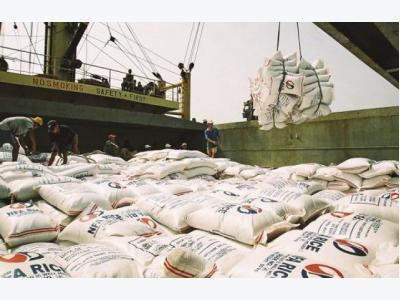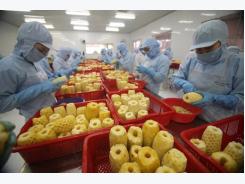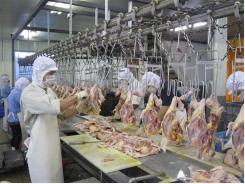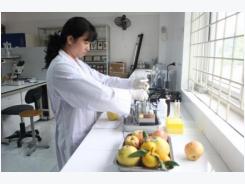Exports still meet difficulties

Vietnam's export activity is forecast to meet many difficulties since importing countries tend to erect non-tariff barriers to protect the post Free Trade Agreement (FTA) domestic commodity producers.
Trong ảnh: Agricultural exports still meet difficulties because of the other countries’ protective barriers. Photo: Internet.
Protectionist tendency is increasingly clear
According to statistics of the General Department of Customs, the country imports and exports in January reached over $US 27.53 billion, down 18.2%, down nearly $US 6.13 billion compared to December of 2016. In particular, exports reached $US 14.34 billion, down 13.5%, in equivalent with $US 2.24 billion; imported nearly $US 13.19 billion, down 22.8%, down nearly $US 3.89 billion from the previous month. However, compared to the same period in 2016, imports and exports in January rose 4.8%, corresponding to an increase of $US 1.26 billion; while exports increased 5.7%, equivalent to $US 768 million; Imports increased 3.9%, equivalent to $US 495 million. The country’s surplus of trade balance in January was more than $US 1.15 billion.
Looking at the statistics of 46 Vietnamese export commodities, there are 4 commodity groups which reached the top of $US billion in January as telephones and components; textiles; computers, electronic products and accessories, and kinds of footwear. In particular, computers, electronic products and components had the highest growth rate over the same period of the year before - 18.7%, followed by textiles 5.7%, telephones and components increased by only 2.6%, while footwear was down 4.8%. These are the items that contribute significantly to the achievement of the country's overall exports. In addition to these items, fruit and vegetables in January had also quite impressive growth of over 16%, earned $US 233 million. This item is still maintaining its “motivation", while items in the group such as tea, pepper, rice, cassava and cassava products sharply declined from 30-40%.
However, if looking shows that, exports have a sign of slowing down as relying on the main export items that are "decelerating". If a few years ago, telephones and components export growth may peak at 30%, but now has fallen to 16% (in 2016). The Textile industry has also endured a difficult and volatile year, grew only 5.2% and missed its objectives since the start of 2016 of $US 31 billion.
An assessment of the overall situation, Mr. Tran Tuan Anh, Minister of Industry and Trade said that in 2017, export activity will face many difficulties due to importing countries tending to erect non-tariff barriers to protect the post-FTA domestic productions. "Therefore, in addition to trade promotion measures to increase export production, the units under the Ministry of Industry and Trade should closely follow market developments and implement solutions to not fall in the trade defense cases", Mr. Tran Tuan Anh requests.
To grow in depth
Vietnam's export growth was over the "hot" period with an increase of 15-16%, because of the fast growing commodities have reached the threshold, while the commodities that Vietnam has advantages over are experiencing numerous barriers from importing countries. Not to mention, many domestic policy mechanisms are causing difficulties for businesses.
The most obvious example is the export of rice being "restrained" by Decree 109/2010/NĐ-CP which regulates conditions for the rice export business. At present, The Ministry of Trade and Industry is drafting a decree to replace Decree 109 and is expected to complete in the second quarter of this year, and consult authorities and enterprises to build the most favorable mechanism for rice exports operation. In the meantime, the rice export companies continue to follow the provisions that are obstructing production and export activities.
Therefore, in 2017, the export target has been lowered (the assigned target of the Parliament and Government was 6-7%, trade deficit was 3.5% of export turnover). Many experts also believe that we should not look at the target of percentage growth, it means that looking at the width but must turn to grow in depth. There is a need to evaluate what are the advantages of Vietnam to have the development orientation to restructure export items.
Mr. Nguyen Mai, chairman of the Foreign Investment Enterprises Association recognizes, in each groups of goods, such as agricultural and fisheries groups, we need to find the goods that Vietnam has advantages. Currently we have a policy to reduce rice exports and increase the export of shrimp. "At the Vietnam shrimp industry development Conference recently, Prime Minister Nguyen Xuan Phuc said that the target which the Ministry of Agriculture and Trade assigned to the export shrimp industry of $US 10 billion by 2030 is too low. The Prime Minister suggested to reach $US 10 billion by 2025", said Mr. Mai. Or as the emerging export item with prospects in 2016 is vegetables, Mr. Mai believes that, if it can be well and systematically invested, will become Vietnam’s advantage commodity.
Thus, for sustainable exporting, Vietnam should only focus on the advantage commodity groups, development of new industrial products with high added value, technological content and high gray matter, thereby earning a higher added value instead of just exporting raw material, like the current processing. Of course, the solutions for market searching and developing still needs to be executed in parallel. For example, China, the major export commodities market, should be sought to exploit and further develop, when our country’s products are meeting difficulties in new markets.
Có thể bạn quan tâm
Phần mềm

Phối trộn thức ăn chăn nuôi

Pha dung dịch thủy canh

Định mức cho tôm ăn

Phối trộn phân bón NPK

Xác định tỷ lệ tôm sống

Chuyển đổi đơn vị phân bón

Xác định công suất sục khí

Chuyển đổi đơn vị tôm

Tính diện tích nhà kính

Tính thể tích ao hồ




 Vietnam's Jan-Feb rice export volume dips, value slides…
Vietnam's Jan-Feb rice export volume dips, value slides…  Agricultural enterprises actively participate in National Single Window
Agricultural enterprises actively participate in National Single Window